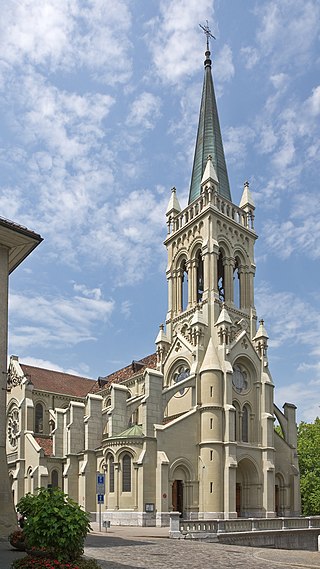
Cologne Cathedral is a cathedral in Cologne, North Rhine-Westphalia belonging to the Catholic Church. It is the seat of the Archbishop of Cologne and of the administration of the Archdiocese of Cologne. It is a renowned monument of German Catholicism and Gothic architecture and was declared a World Heritage Site in 1996. It is Germany's most visited landmark, attracting an average of 6 million people a year. At 157 m (515 ft), the cathedral is the tallest twin-spired church in the world, the second tallest church in Europe after Ulm Minster, and the third tallest church of any kind in the world.
The Oberbergischer Kreis is a Kreis (district) in the state of North Rhine-Westphalia, Germany. Neighboring districts are Ennepe-Ruhr, Märkischer Kreis, Olpe, Altenkirchen, Rhein-Sieg, Rheinisch-Bergischer Kreis, and the urban districts Remscheid and Wuppertal.

Hürth is a town in the Rhein-Erft-Kreis, North Rhine-Westphalia, Germany. Hürth shares borders with the city of Cologne and is about 6 km to the southwest of Cologne city centre, at the northeastern slope of the natural preserve Kottenforst-Ville. The town consists of thirteen districts, once independent villages, and is distributed over a relatively large area. The municipal area is interspersed with lakes and stretches of forest.

Levice is a town in western Slovakia. The town lies on the left bank of the lower Hron river. The Old Slavic name of the town was Leva, which means "the Left One".

Bergneustadt is a municipality in the eastern part of the Oberbergischer Kreis (district), in North Rhine-Westphalia, Germany. It is located 50 km east of Cologne. It is part of the Berg region.

Reichshof is a North Rhine-Westphalian municipality in the Oberbergischer Kreis in Germany, about 40 km east of Cologne. It is a health resort, known for its good climate. The municipality consists of 106 villages and hamlets. The most important villages are Denklingen, Eckenhagen (1900), Brüchermühle (1700) and Wildbergerhütte (1600).
The Free Catholic Church in Germany is a Christian religious community in Germany which was legally registered in 1987.

The Christian Catholic Church of Switzerland is an Old Catholic denomination in Switzerland. This denomination is part of the Union of Utrecht.

Gerolstein is a town in the Vulkaneifel district of Rhineland-Palatinate, Germany. Gerolstein is a local municipality of the Verbandsgemeinde Gerolstein. It has been approved as a Luftkurort.
Burstall is a small town in southwestern Saskatchewan, Canada.

Modrý Kameň is a town and municipality in the Veľký Krtíš District of the Banská Bystrica Region of southern Slovakia.

Sološnica is a village and municipality in western Slovakia in Malacky District in the Bratislava Region.

Rechberghausen is a town in the district of Göppingen in Baden-Württemberg in southern Germany.

The Diocese of Liège is a Latin Church ecclesiastical territory or diocese of the Catholic Church in Belgium. The diocese was erected in the 4th century and presently covers the same territory as Belgium's Liège Province, but it was historically much larger. Currently, the diocese is a suffragan in the ecclesiastical province of the Archdiocese of Mechelen-Brussels. Its cathedra is found within St. Paul's Cathedral in the episcopal see of Liège.

St. Maria im Kapitol is an 11th-century Romanesque church located in the Kapitol-Viertel in the old town of Cologne, Germany. The name “im Kapitol“ refers to the Roman temple for the Capitoline Triad that was built on today’s site of the church in the first century. The Catholic church is based on the Church of the Nativity in Bethlehem, was dedicated to St. Mary and built between 1040 and 1065. It is one of twelve Romanesque churches built in Cologne during this period.

The Basilica of the Holy Apostles is a Romanesque church in Cologne (Köln), located near Innenstadt's busy Neumarkt (Köln). The former collegiate church is dedicated to the twelve Apostles. It is one of the twelve Romanesque churches built in Cologne in that period.

The Church of the Holy Family, also known as the Chapel of the Holy Family, is a Catholic church building located in the Austrian Hospice in the Old City of Jerusalem.

The Ordinariate for Byzantine-Rite Catholics in Austria is a Catholic Ordinariate for Eastern Catholic faithful jointly for all Eastern Catholics of Byzantine Rite in the various languages of particular churches sui iuris in Austria.

The ruins of Reifferscheid Castle stand at a height of 450 metres above sea level (NN) near the German-Belgian border between the mountains of the Eifel and the Ardennes in the municipality of Hellenthal. Its name probably comes from a forest clearing that belonged to a man called Rifhari, the names Rifersceith or Rifheres-sceit mean "woodland strip of Rifhari".
















